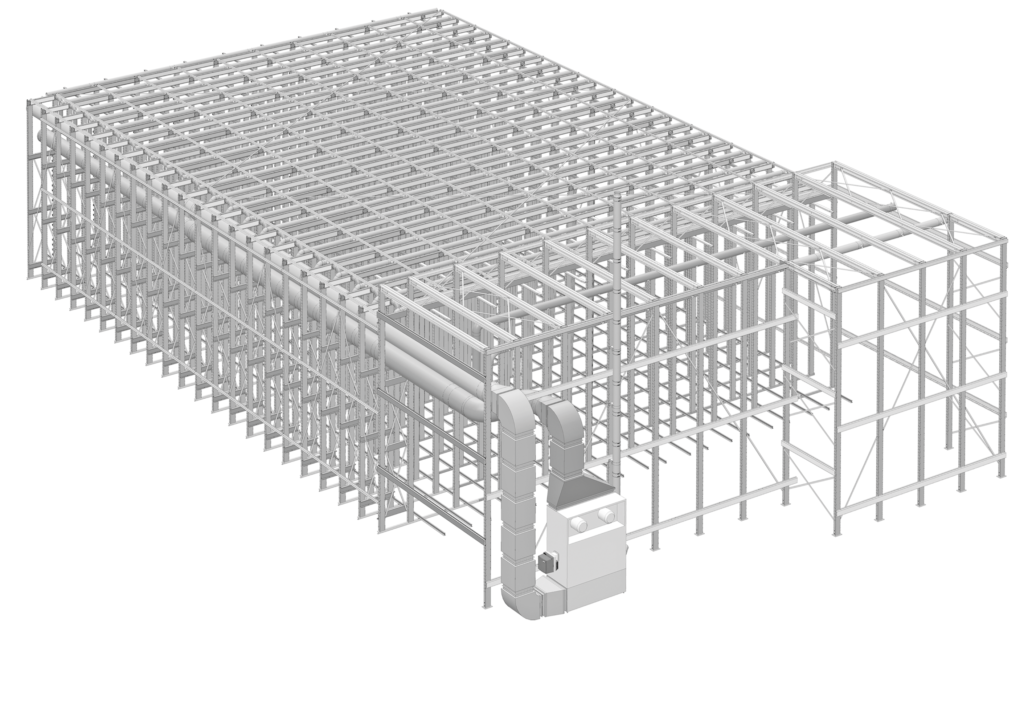KRAFT TRUE CURING RACKS®

The KRAFT CURING RACK® is the first and only true rack combining storage and concrete curing on the market. Its uniqueness lies in the combination of both functions, based on an FEM-optimised design that integrates the controlled curing of concrete into the supporting structure. The result is an even distribution of air and heat and an optimum curing climate at every point in the chamber.
Benefits for the customer:
- even distribution of air and heat
- simple integration of QUADRIX® or NAUTILUS®
- integrated corrosion protection
- economical design & structure
Kraft Curing guarantees:
- Curing system fully integrated into the racking system
- Computer-optimised rack design (FEM calculations) ensures extremely high stability and durability
- Excluded rack anchoring failures due to knock-on effects after shelf failure or board breakage
- Simple levelling of the entire system
- Perfect guidance of the production boards
- 50-year guarantee against rusting when used with the Quadrix® curing system

KRAFT CURING RACK® are an innovative project in which the load-supporting structure and the single components are designed on the basis of modern technologies:
◎ FEM (Finite-Elemente-Methode):
In order to improve the load-bearing structure, Kraft based its solution on modern technology. A new design was developed for the individual rack parts according to the principles of the "Finite-Elemente-Methode" (FEM).
This method involves calculating all the loads to which the structure is subjected in a special computer simulation. The operation takes several hours for each part to be calculated and takes several months in total. On the basis of these calculations, the programme develops an optimised structure that is adapted to the project requirements and demonstrates high stability and durability.
◎ Galvanised steel supports:
The rack supports are made of galvanised steel with a thickness of 3-5 mm. Thanks to a special galvanising method (piece by piece), the coating is extremely durable.
◎ New design of the support rails:
The support rails of the KRAFT RACKS® are made of 1.75 mm thick steel and require less steel than most conventional support rails, but offer greater strength.
The new design of the support rails integrates the rails that guide the boards along their entire length. This means that there is no misalignment of the production boards between the shelf supports.
Thanks to the special fastening of the supports, the phenomenon known as "pancaking", i.e. the falling out of the production boards, which results in repeated damage to the rack anchorage, no longer occurs.
◎ Columns connected to the rack foundation structure:
The columns are also no longer directly connected to the ground, but to the rack base structure. This design innovation makes it possible to level the rack supports and rails simultaneously and thus much more easily and accurately.
◎ Certified by the Institute of Statistics:
The engineering and development of the optimised rack parts right up to their introduction into production was monitored and certified by a renowned statics institute. FEM calculations show the weaknesses of the traditional rack profile.
FEM calculations show the weaknesses of the traditional rack profile. With the same force, the rails and other racking components are much weaker and more sensitive to deformation.
◎ Possibility of integrating a curing system:
The improved design is not the only advantage. The racking system is designed in such a way that the maintenance of the curing parameters in the curing chamber can be carried out through the supporting structure. The Quadrix and Nautilus systems, for example, can be connected directly, without the need for additional structural extensions.
When equipping a plant with new Kraft racks, the producer can decide at any time to upgrade a simple system by implementing air distribution with or without heating, or additional humidification and dehumidification.
The distribution system integrated into the racks will reliably distribute air, moisture and heat to every part of the chamber, ensuring an even more accurate and uniform distribution of the desired curing parameters, regardless of the size of the chamber.
"The use of this procedure results in the entire supporting structure being constantly dry despite the optimum humidity for the curing process. As a result, the system is protected against corrosion and does not need to be replaced for a long time" - says Michael Kraft


You must be logged in to post a comment.